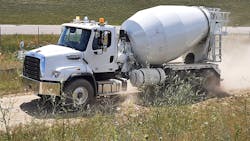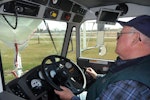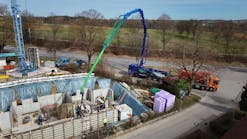The word “plus” means there’s more to come, and that’s the case with the Plus enhancements to Freightliner’s M2 and SD line of medium- and heavy-duty trucks. The betterments include new driver-pleasing interiors and advanced multiplexed electrical systems, and newly optional Detroit Assurance safety systems. The additions will be applied to the on-road M2 106 and M2 112, and the severe-duty 108SD and 114SD. I drove the 114SD 10-wheel mixer truck shown in the photos, but also drove and inspected other Freightliner and Western Star trucks and tractors on the premises of the American Center for Mobility in Ypsilanti, Michigan. The two truck makes, and the Detroit-branded components used in them, are all owned by Daimler Trucks North America.
The event was last summer, far in advance of Plus series production, partly to allow customers time to choose between the new or current models, according to a Daimler executive. Supply-chain problems at the time had stretched out truck production, and long lead times between orders and deliveries remain. Customers need to order early to have trucks when they need them. The Plus-equipped M2 and SD vehicles will enter production in the third quarter of this year, so now would be a good time to place orders. Although current models are pretty decent machines (I wouldn’t mind working in one of them), the latest in any product is usually more desirable.
How does the Freightliner 114SD drive?
Driving the 114SD mixer around the test center’s premises illustrated that. The truck rode well on or off road, and at highway speeds was admirably quiet and comfortable. The off-road trails were mostly dirt and gravel, but some obstacles posed a real test of the 6x4 vehicle’s suspensions and chassis, which soaked up lots of shock but couldn’t mask the deep ruts that ran perpendicular to the pathways. My guide and I bounced around but still enjoyed the ride. One obstacle I avoided was a large watery mud pit, especially after another truck—a municipal-spec dumper—wedged the snowplow mounted on its front end into the pit’s dirt wall. I did bang through a shallower and drier mud pit, which our mixer truck handled easily.
The cab was the same aluminum-over-steel structure used on current models, complete with large windows for good outward visibility and sizable door openings through which to enter and exit. Windshield glass is said to be especially resistant to impacts from stones and other flying road debris. The new Plus interior trim on all models uses nicer-looking and -feeling panels. This truck’s redesigned dashboard sported a matte-black finish; a digital instrument panel had virtual gauges and a driver information screen directly ahead, and a larger screen sat in the secondary panel to the right. That panel is said to possess 2.5 times more space than before for mounting of switches and controls. They are part of the multiplexed electrical system and can be configured to operate many truck body functions. This cab, though, was outfitted with a separate control console tied to the Beck mixer body; the console had a joystick and touch-operated icons to manage drum operation for loading and discharging of the concrete load. This day the drum carried gravel to give us some realistic but dry weight with no danger of prematurely hardening.
Freightliner SD114 powertrain
Under the hood was an 11.9-liter Cummins X12 diesel, notable because Daimler is the only major truck builder that offers the lightweight engine, even though it has a 13-liter Detroit diesel that could be considered a competitor. Most other truck builders will sell only their own diesels in this displacement class. The X12 weighs several hundred pounds less than the DD13 (and other proprietary diesels in other makes) and can be repaired at shops other than the truck dealer’s, which is an advantage if the dealer’s shop has a long waiting line. Because most of my driving with this mixer truck was on the off-road trails, I didn’t use many of the X12’s 440 horses, but its hefty torque came in handy. And it was easily applied through the stout Allison 4700 automatic transmission: Just touch the accelerator and go; release it to slow down.
Several other trucks available for driving during this event had the Detroit DT12 automated gearbox, which was almost as easy to use but lacked the cushioning of the Allison’s torque converter. Allisons have therefore become popular among buyers of on/off-road vocational trucks and manual gearboxes are becoming scarce, as are people who know how to drive them. Automatic and automated transmissions in all Freightliners are controlled with a stalk on the right side of the steering column. The wheel’s rim and spokes sometimes block the driver’s view of the stalk, but it’s easily operated by feel. Settings are few and simple: D, N, and R, with a separate M-for-manual switch that enables greater control of tranny ratios. Moving the stalk downward engages the engine brake through three stages, as with toggle or rocker switches on older trucks’ dashboards; when the stalk is all the way up, the engine brake is off.
Earlier in the day, Freightliner reps lined up three vocational trucks with differing specifications and missions: this 114SD mixer, another 114SD with a sewer-vacuum body (its outsized collection box and large forward-mounted hose reel and control switches made an intriguing package, but it was not available for driving); and the Omaha orange 108SD muni dump truck with the snowplow mount that later caught itself in the watery mud pit. Their intent was to show some of the SD series’ capabilities, in these examples oriented toward construction and infrastructure maintenance. In another display were Western Star premium vocational trucks with similar versatility, giving customers a choice between two brands.
Daimler is rationalizing some of the components that have been separately built by its two brands, primarily cabs, while powertrain offerings and Detroit Assurance safety equipment are the same in each line. Daimler has also dropped two models: the long-nose Freightliner 122SD, whose buyers will be directed toward the recently introduced Western Star 49X, and the ‘Star 4800, whose applications will be handled by the 49X or the 47X, or perhaps a Freightliner 114SD Plus, like the one I drove. Most of Daimler’s dealers now sell both truck makes, so brand crossovers might increase, and either way customers can benefit from reliable support that Daimler demands of its dealers.







